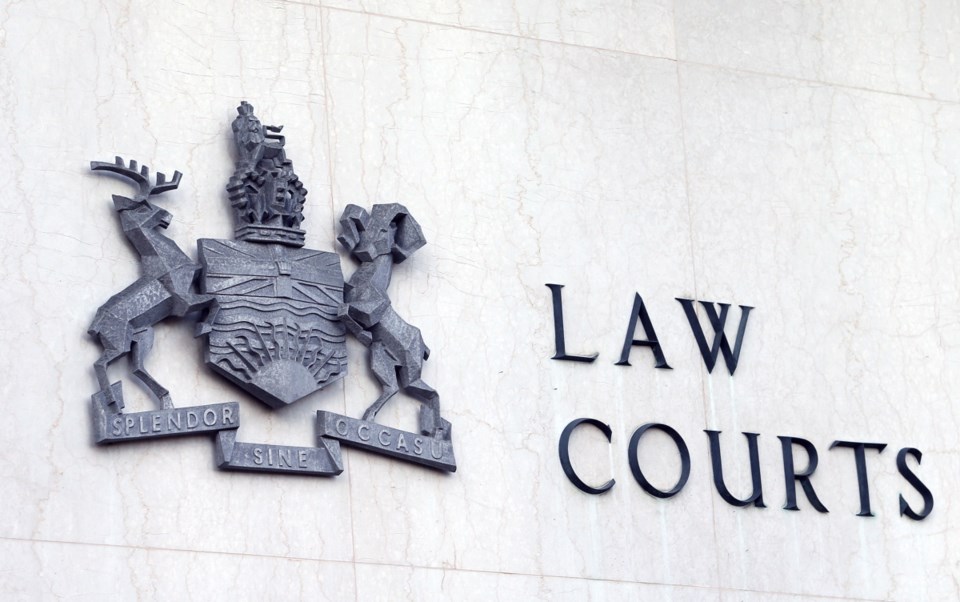A B.C. Supreme Court jury is deliberating whether Andrew Johnathan Belcourt intended to kill a mentally ill Fernwood man during a robbery in his apartment in March 2010.
On Wednesday, jurors listened to closing submissions from Crown and defence, then received final instructions from B.C. Supreme Court Justice Keith Bracken. The jury, which has been sitting since Jan. 31, began deliberations late Wednesday and is now sequestered.
This is the Belcourt’s second trial in the death of Leslie Hankel, a 52-year-old who had paranoid schizophrenia and lived alone in an apartment at 1260 Pembroke St.
In November 2012, a jury convicted Belcourt of second-degree murder. Belcourt’s co-accused, Samuel McGrath, was convicted of manslaughter. Both had pleaded guilty to break-and-enter and robbery with a firearm.
Belcourt appealed his conviction on the grounds that the trial judge did not properly instruct the jury on whether he had the necessary intent for murder. In March 2015, the Court of Appeal unanimously allowed his appeal and ordered a new trial.
At the outset of this trial, Belcourt offered to plead guilty to manslaughter. That plea was not accepted by the Crown.
The Crown’s theory is that Belcourt and McGrath planned to carry out a home invasion and steal a stash of marijuana from an apartment on Pembroke Street. On the night of March 2, 2010, McGrath bought a shotgun from Michael Rennie, Belcourt’s stepfather. Rennie showed them how to load and assemble the shotgun.
Belcourt and McGrath then went to the Johnson Street townhouse where Belcourt was staying. They dressed in dark clothing, and Belcourt assembled and fully loaded the gun. They went to Hankel’s apartment just before 1 a.m.
Belcourt and McGrath used violence from the start, said prosecutor Patrick Weir. Armed with a loaded shotgun, they kicked down the door of Hankel’s apartment and rushed in, faces masked.
Belcourt ordered Hankel to get on the floor. He asked where the weed was and hit Hankel with the shotgun. They ransacked his home, tore his bedroom apart and flipped his mattress in a search for marijuana that wasn’t there.
Belcourt was prepared to use whatever force was necessary to gain Hankel’s compliance and protect his identity, even if it meant using the loaded shotgun, Weir said.
The shotgun was fired twice in the bedroom. The first shot was fired at the ceiling. The second was fired at Hankel, hitting him in the side of his face and neck, killing him almost instantly.
Weir urged the jury not to believe Belcourt’s testimony that the shotgun discharges were accidental.
Two Crown witnesses, Chantel Young and Max Deleeuw, testified that Belcourt told them he had to shoot Hankel because his mask fell down during the robbery.
During his closing submissions, defence lawyer Tim Russell told the jury that Belcourt’s testimony is believable and supported by the evidence.
The Crown’s evidence of Belcourt’s actual intention to kill is weak and raises a reasonable doubt, Russell said.
Although Belcourt admitted telling Young that his mask fell off, the jury can’t be sure of what he actually said, how he said it or why, said Russell. The defence lawyer noted that both Belcourt and Young were intoxicated. He suggested Belcourt was making something up to impress Young or to end her persistent questioning.
The jury should also question Deleeuw’s evidence because of his strong connection to Rennie, “whose character is not just unreliable, but shows both a clear motive to lie and a history of lying and manipulating the justice system to his own advantage.”
Both Young and Deleeuw admitted they lied to police and have lied under oath, Russell noted.
The combined effects of alcohol, a lack of firearms training and the “slam-fire” or “rapid-fire” capability of the Ithaca 37 shotgun, which allows the weapon to be discharged if its trigger is depressed, makes the likelihood of accidental discharge very high, he said.
During the trial, a firearms expert testified that if the shotgun is discharged and the person holding the shotgun operates the slide to eject the spent shell without releasing the trigger, the weapon could fire accidentally.
The expert testified the slam-fire feature is an additional layer of complexity that makes the firearm more dangerous and that the risk of accidental discharge increases with lack of experience and knowledge.
Russell said the jury should believe Belcourt or at least be left in a reasonable doubt by his evidence. He urged the jury to convict his client of manslaughter.
On Thursday, the jury returned to court asked to examine the shotgun in the jury room.
They later asked to listen to passages of Belcourt’s testimony again.



